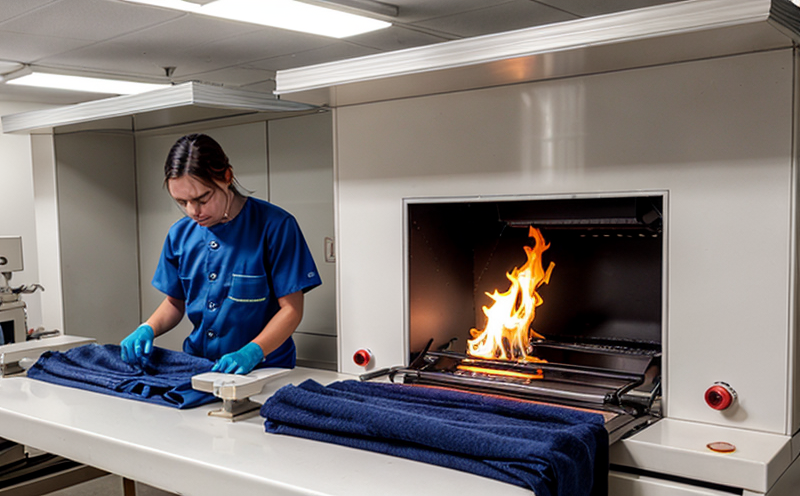Fire Safety Evaluation of Industrial Textile Products
The fire safety evaluation of industrial textile products is a critical service that ensures compliance with international standards and regulations. The sector of fire safety testing encompasses a wide range of applications, including the assessment of materials used in various industries such as construction, automotive, aerospace, and personal protective equipment (PPE). This service is particularly important for industrial textiles due to their frequent use in environments where fire hazards are present.
Textile & apparel flammability testing plays a vital role in ensuring that industrial textile products meet strict safety requirements. The primary focus of this evaluation is to determine the resistance of these materials to ignition and flame spread, thereby safeguarding end-users from potential risks. The service involves rigorous testing procedures that simulate real-world scenarios where textiles may encounter fire hazards.
One of the key aspects of industrial textile product evaluation is understanding the specific needs and requirements of the industries they serve. For instance, aerospace textiles must withstand high temperatures and intense flames while maintaining structural integrity, whereas PPE textiles need to be highly flame-resistant yet comfortable for extended wear. This tailored approach ensures that each material undergoes testing relevant to its intended use.
The evaluation process typically begins with specimen preparation, ensuring that the sample accurately represents the product under test conditions. Next comes the selection of appropriate test methods based on industry standards such as ISO 13565-2 for horizontal test methods or DIN 53438 for vertical test methods. These tests assess various parameters including flame spread rate, heat release rate, smoke production, and char depth.
Once testing is complete, detailed reports are generated that provide comprehensive data on the performance of each material tested. These reports serve as valuable tools for manufacturers to improve their products continuously by identifying areas where improvements can be made. Additionally, they play an essential role in meeting regulatory requirements and gaining certification from relevant bodies.
In summary, fire safety evaluation of industrial textile products is a multi-faceted service that involves meticulous preparation, state-of-the-art testing methodologies, and thorough analysis to ensure product safety and compliance with international standards. By focusing on real-world applications and specific industry needs, this service helps protect workers and environments from potential hazards associated with flammable materials.
Benefits
The benefits of fire safety evaluation extend beyond mere compliance; they encompass improved product reliability, enhanced worker safety, increased market competitiveness, and reduced liability risks. Firstly, by ensuring that industrial textile products meet stringent fire safety standards, manufacturers can build trust with their customers, which ultimately translates into higher customer satisfaction and loyalty.
Secondly, meeting these standards reduces the likelihood of accidents or incidents involving flammable materials, thus protecting both employees and consumers from harm. This not only enhances workplace safety but also contributes positively to corporate social responsibility initiatives.
Thirdly, successful completion of fire safety evaluations can lead to significant cost savings by preventing product recalls due to non-compliance issues. Moreover, it opens up new market opportunities as compliant products are more attractive to buyers seeking high-quality, safe alternatives.
Lastly, having a robust fire safety evaluation process in place demonstrates a commitment to excellence and innovation within the company culture. It signals to stakeholders that you prioritize quality control and continuous improvement, which can be a decisive factor when competing against other firms in the same market segment.
Competitive Advantage and Market Impact
The fire safety evaluation of industrial textile products offers several competitive advantages that significantly impact the market. One significant advantage is enhanced reputation among customers who value safety above all else. By consistently delivering top-tier fire safety evaluations, companies establish themselves as leaders in their respective fields.
Another advantage lies in increased brand recognition and loyalty. Customers are more likely to choose products from trusted brands they know adhere strictly to international standards. This leads to repeat business and referrals, further boosting market share.
Furthermore, compliance with fire safety regulations provides a strong defense against legal challenges or potential liabilities arising from non-compliant products. It also facilitates smoother operations by avoiding unnecessary disruptions caused by recall orders or other regulatory actions.
In addition to these benefits, successful completion of fire safety evaluations can open doors to lucrative export markets where stringent safety requirements must be met before entry is allowed. This expands the customer base and increases revenue streams for companies operating globally.
Lastly, maintaining a high level of fire safety evaluation standards sets an example within the industry, encouraging others to follow suit. This collective effort contributes to overall improvements in workplace safety across all sectors utilizing industrial textiles.
Use Cases and Application Examples
| Application Example | Description | Testing Methodology | Key Parameters Measured |
|---|---|---|---|
| Aerospace Cabin Linings | Critical components that must withstand extreme temperatures and flames without compromising structural integrity. | ISO 13565-2 Horizontal Test Method | Flame Spread Rate, Heat Release Rate, Smoke Production Index |
| Bulletproof Vests | Highly flame-resistant garments designed to protect officers from potential fire hazards. | DIN 53438 Vertical Test Method | Thermal Insulation, Flame Spread Rate, Mass Loss |
| Fabricated Fire Curtains | Automatically deployable barriers used in commercial buildings to contain fires and prevent spread. | EN 13501-2 Standard Test Method | Smoke Production Index, Flame Spread Rate, Structural Integrity |
| Fireproof Clothing | Specialized garments worn by firefighters during firefighting operations to protect against intense heat and flames. | ASTM E672 Standard Test Method | Thermal Insulation, Flame Resistance, Durability |
The use cases highlighted above illustrate how fire safety evaluation of industrial textile products plays a crucial role in various industries. Each application requires specific testing methodologies tailored to the unique challenges faced by that particular sector. By adhering strictly to these protocols and measuring key parameters accurately, companies can ensure their products meet all necessary requirements for safe operation.





